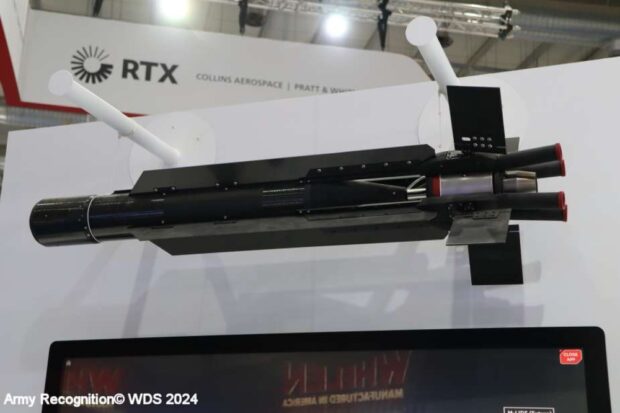At the World Defense Show 2024 (WDS 2024) exhibition in Saudi Arabia, Raytheon, now part of RTX Corporation, is displaying its Coyote Block 2+ kinetic effector. This variant is designed as a low-cost, rail-launched missile solution for Counter-Unmanned Aircraft System (C-UAS) missions, with a boost rocket motor and a turbine engine.
According to Raytheon, the Coyote Block 2+ kinetic effector, which can be rail-launched, is capable of targeting a range of Unmanned Aircraft Systems (UAS), including small to large drones, at extended distances and higher altitudes compared to similar systems. It can engage both single drone threats and swarms with reduced engagement timelines, improving its multi-target capability.
When coupled with Raytheon’s Ku-band Radio Frequency Sensor (KuRFS radar), the Coyote system contributes to the detection and defeat capabilities against UAS threats in the US Army’s counter-UAS solution, known as LIDS (Low, slow, small, unmanned aircraft Integrated Defeat System).
The Coyote Block 2+ kinetic effector serves as a capability in addressing Group 1-3 UAS threats. It completed flight test qualification in December 2019, allowing for its deployment by the US Government in 2020. Its primary role is to provide a kinetic defeat solution against asymmetric UAS threats, ensuring protection for bases and critical sites.
The Coyote Block 2+ is characterized by its low-cost, rail-launched design and turbine engine, making it suitable for C-UAS missions. It has demonstrated its effectiveness against small maneuvering UAS threats with a rapid time-to-target capability. The system can be integrated into both fixed and mobile platforms, enhancing mission flexibility. It relies on command and control guidance via a fire control radar, transitioning to onboard seeker guidance for terminal engagement. The endgame involves the detonation of a forward-firing, low-collateral blast fragmentation warhead, ensuring precision and minimizing unintended damage.
Its features include capabilities for Group 1-3 targets, ease of integration on various mobile and fixed site platforms, solutions for enhanced capability, and increased probability of kill (Pk) while maintaining cost-efficiency. The system is user-friendly, requiring training and maintenance support. It is adaptable for use across fixed sites and transportable configurations, with a launcher system designed for distributed setup to maximize base and critical site protection.
The Coyote Block 2+ system comprises a combination of Commercial Off-The-Shelf (COTS) and designed components. It includes a data link, a Raytheon Missiles & Defense common MP-7U guidance electronic unit, a launch rocket motor, and a thrust jet engine for rapid intercepts at distances exceeding 10 kilometers. The Block 2+ relies on the Coyote launcher data link and the FAAD Command and Control system for guidance updates during the flight profile. In the terminal guidance phase, the onboard seeker and proximity fuze take control for end-game targeting refinement and warhead detonation. The system is equipped with a tungsten fragmentation warhead optimized for C-UAS missions.
The Block 2+ Electronic Safe and Arming Device (ESAD) fuze offers safety and reliability features, such as pitot static airspeed, terminal arming, and return to readiness capabilities. These features accommodate the Block 2+’s ability to re-attack the target multiple times to increase the probability of a successful kill (Pk). The system includes “Adaptive Autopilot” technology for missile performance in challenging flight conditions and offers air traffic avoidance capabilities to ensure the safety of friendly aircraft while tracking hostile targets. Additionally, it features auto-air termination and “loitering with re-engagement” capability for situations where ground-based communication or guidance data may be interrupted.
The Coyote effector can be launched from palletized fixed-site Coyote launchers as well as mobile Coyote launcher systems. These launch systems are integrated with both Fixed Site LIDS and mobile systems, allowing for engagement of multiple hostile target scenarios and ensuring protection against threat raids.
In terms of capabilities, the Coyote Block 2+ system enables defense against multi-axis, multi-threat attacks, covering Group 1-3 target sets. It offers re-attack capability, incorporates system safety logic including aero-termination, and boasts maneuverability and speeds. Its flight time extends up to approximately 4 minutes, and it provides a kinetic defeat capability against low-cost Group 1-3 threats. The system is presented in a fixed site palletized launcher configuration, allowing for magazine depth per site.
The mobile variant of the Coyote Block 2+ is characterized by a forward-firing, low collateral blast fragmentation warhead effective against Group 1-3 threats. With a length and weight, it offers mobility and versatility. It features a C-Band datalink, launch assist boost rocket motor, and turbine engine propulsion, along with rapid reload capability. The system requires personnel for operations, boasts a small, lightweight footprint, and utilizes JP10 fuel for cost-effectiveness.
Source: Army Recognition

